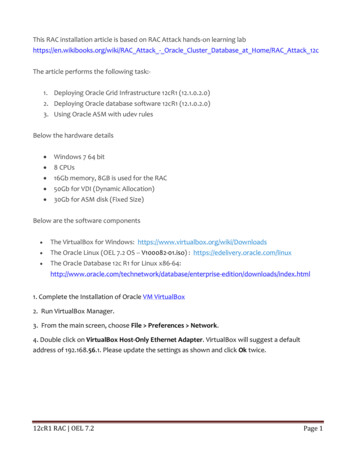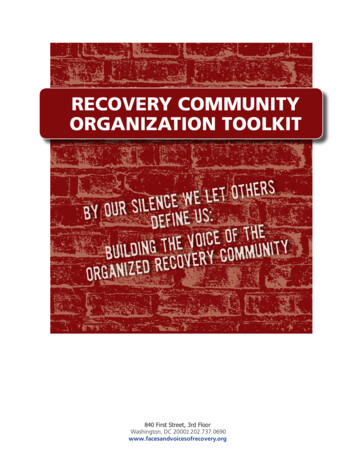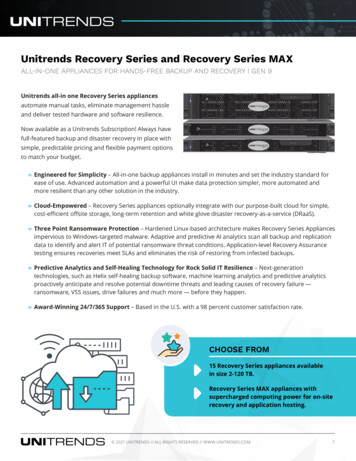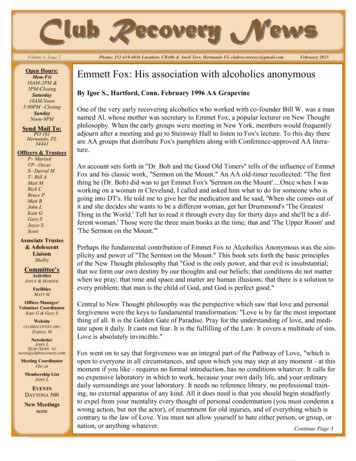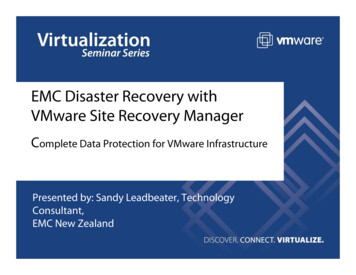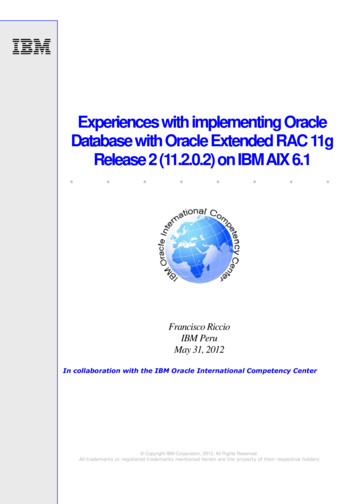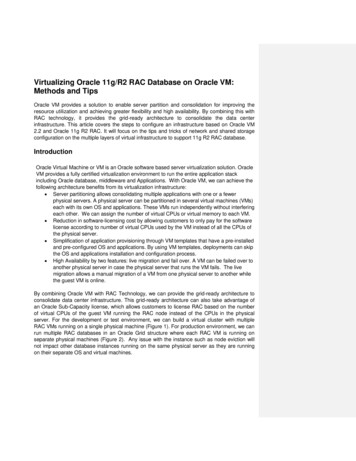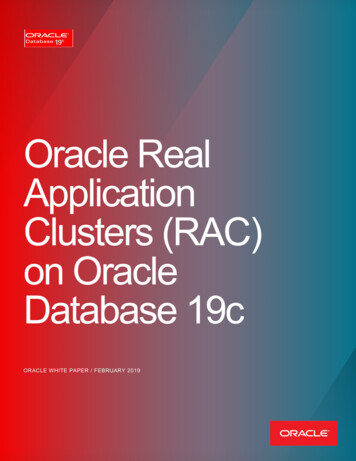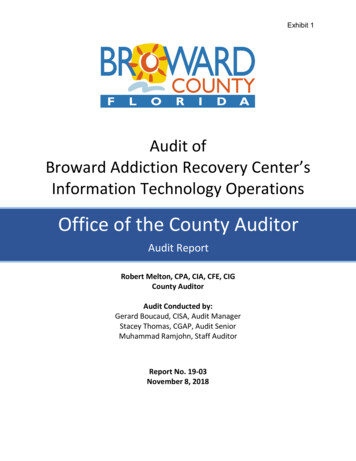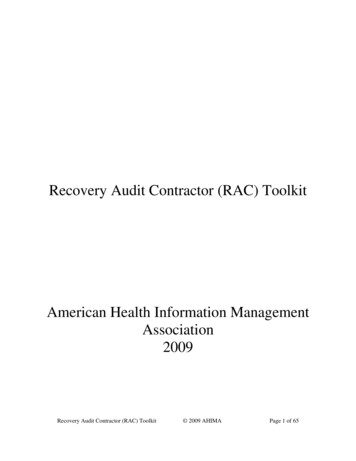
Transcription
Recovery Audit Contractor (RAC) ToolkitAmerican Health Information ManagementAssociation2009Recovery Audit Contractor (RAC) Toolkit 2009 AHIMAPage 1 of 65
Table of ContentsForeword .4Authors .4Introduction .5Background .5Audit Process .6Preparation Checklist . . 8Hierarchy of Authority .8Internal Policies and Procedures. . .8Education .10Appeals .10Resources. . 11Appendix A: Preparation Checklist . . .13Appendix B: Hierarchy of Authority Samples . .16Appendix C: RAC Coordinator Job Description Sample . .23Appendix D: Policy and Procedure Sample . .24Appendix E: RAC Record Extension Request Sample . .26Appendix F: Developing a RAC Education Program . .27Appendix G: RAC Presentation Sample . .29Appendix H: RAC Acronyms . .52Appendix I: RAC Determination Response . .53Appendix J: Appeal Process Workflow . . .55Appendix K: Medicare Appeals Process . .56Recovery Audit Contractor (RAC) Toolkit 2009 AHIMAPage 2 of 65
Appendix L: Sample Appeal Letters . .58Appendix M: Appeals Submission Checklist . .65Recovery Audit Contractor (RAC) Toolkit 2009 AHIMAPage 3 of 65
ForewordClinical coding and reimbursement plays a significant role in healthcare and has gained moreattention in the last decade with the introduction of present on admission (POA) indicators,Ambulatory Payment Classifications (APCs), MS-DRGs, and most recently ICD-10-CM/PCS.While medical record audits have existed in the past to identify improper payments and preventfraudulent claims, the Recovery Audit Contractor (RAC) program’s scope and volume ofmedical record requests is much greater. Healthcare entities must understand the RAC auditprocess and establish policies and procedures to appropriately manage the incoming requests, aswell as the denial and appeal processes.This toolkit provides guidance to health information management (HIM) professionals on how toprepare for and ensure compliance with the permanent program, including identifying an internalsupport team, developing policies and procedures, establishing an educational program, andfollowing through with the responses to the RAC. While the information contained within thistoolkit is specific to the RAC program, its guidance can be used for other anticipated regulatoryaudits. However, the appropriate modifications would need to be made to requirements forextensions, processes, etc.AuthorsJill S. Clark, MBA, RHIAGail Garrett, RHITSarah Hurst- studentLinda A. Hyde, RHIALaurie M. Johnson, MS, RHIA, CPC-HKrystal M. Lloyd, RHIA, CCSAnita Majerowicz, MS, RHIAShelley C. Safian, MAOM/HSM, CCS-P, CPC-H, CPC-I, CHADonna Wilson, RHIA, CCSAcknowledgmentsAngela K. Dinh, MHA, RHIACheryl Gregg Fahrenholz, RHIA, CCS-PMargaret M. Foley, PhD, RHIA, CCSKathy Fox, RHIA, CCS, CCS-P, CHCWanda Johnson, RHITJane M. Kelly, PhD, CPCFaith Neal, RHIA, CCS, CHP, CPHQ, CPHRM, CSHAAllison Viola, MBA, RHIARecovery Audit Contractor (RAC) Toolkit 2009 AHIMAPage 4 of 65
IntroductionHIM professionals should have a fundamental understanding of the entire RAC process in orderto appropriately support and guide their healthcare entity in complying with the program.Best practice guidance provided in this toolkit was developed for use across all healthcareentities. Therefore, the tools used may vary depending on the role of the individual and type ofhealthcare entity. All information included within the toolkit at the time of publication is current.For the purposes of this toolkit, healthcare entity encompasses all providers: short-term acutecare hospitals; long-term acute care hospitals; skilled nursing facilities and hospices; inpatientand outpatient psychiatric and rehabilitation facilities; home health facilities; hospital-basedoutpatient facilities and clinics; and all professional providers such as physician practices andother healthcare entities or professional providers that provide patient care solo or as part of acorporation and accept payment from Medicare. The healthcare entity uses the same policies andprocedures throughout the components of the organization.BackgroundIn section 306 of the Medicare Prescription Drug, Improvement, and Modernization Act of 2003(MMA), Congress directed the Department of Health and Human Services (DHHS) to conduct athree-year demonstration program using RACs to detect and correct improper payments in theMedicare Fee for Service (FFS) program.The demonstration program was designed to determine whether the use of RACs was a costeffective means of ensuring correct payments to providers and suppliers and, therefore,protecting the Medicare Trust Fund.The RAC demonstration program was successful in returning dollars to the Medicare Trust Fundand identifying monies that need to be returned to providers. It provided the Centers forMedicare and Medicaid Services (CMS) with a new mechanism for detecting improper paymentsmade in the past and has also given CMS a valuable new tool for preventing future inappropriatepayments.Therefore, section 302 of the Tax Relief and Health Care Act of 2006 makes the RAC programpermanent and requires the DHHS Secretary to expand the program to all 50 states by no laterthan January 1, 2010. Each RAC will be responsible for identifying overpayments andunderpayments in approximately a quarter of the country. The new RAC jurisdictions match thedurable medical equipment Medicare administrative contractors (DME MACs) jurisdictions.Please reference the CMS Web site www.cms.hhs.gov/RAC/ for information on the RACjurisdiction map, schedule, and contractor information.Recovery Audit Contractor (RAC) Toolkit 2009 AHIMAPage 5 of 65
Audit ProcessWho Is Eligible to Be Audited?RACs are authorized to investigate claims submitted by all physicians, providers, facilities, andsuppliers—essentially everyone who provides Medicare beneficiaries in the fee for serviceprogram with procedures, services, and treatments and submits claims to Medicare (and/or theirfiscal intermediaries (FI), regional home health intermediaries (RHHI), Part A and Part BMedicare administrative contractors (A/B/MACs), durable medical equipment Medicareadministrative contractors (DME MACs), and/or carriers. More information on those eligible forRAC audits can be found within the “Preparation Checklist” in appendix A.Basis for the AuditNow that the RACs have been assigned for a specific region of the country, they will receive aclaim’s file from CMS. The file contains the past claim’s data from the National Claims History(NCH), compiling the claims that have been processed and paid after 10/01/07 in that assignedregion. Monthly updates, including the current fiscal year, will be sent thereafter.RACs employ their own custom-designed computer programs and processes, utilizing theiruniquely developed criteria based on Medicare rules and regulations, accepted clinical standardsof medical practice, and coding and billing policies, to determine which specific sectors toreview. They may also reference specific services included in the current year Office of theInspector General’s (OIG) work plan as well as Government Accountability Office (GAO) andComprehensive Error Rate Testing (CERT) findings. From this foundational information, theRAC will identify those situations in which claims have a high probability to be overpaid (andunderpaid) in their region. These qualifiers are then entered into the RAC database for eachclaim to identify providers and begin the analysis and recoupment process.Similar to FI Audits, but RAC audits are based on proprietary methodologies developed by each contractor using CMSrules and regulations, national and local coverage determinations, etc. This method is similar tothose conducted by FIs when they are looking to identify improper payments and fraudulentclaims. However, RACs are paid by contingency fees based on the amount of over- andunderpayments they identify. This means their motivations may be slightly different.Additionally, it is important to note the RAC will report potential fraud to CMS and potentialquality issues to quality improvement organizations (QIOs).All RACs are required to employ professional clinicians, including a physician, medical director,nurses, therapists, and certified coders for their assessments.Types of AuditsThere are two types of audits: automated reviews and complex reviews. An automated reviewoccurs when a RAC makes a claim determination at the system level without a human review ofthe medical record, such as data mining. Errors found must be clearly noncovered services orRecovery Audit Contractor (RAC) Toolkit 2009 AHIMAPage 6 of 65
incorrect application of coding rules and must be supported by Medicare policy, approvedarticle, or coding guidance.A complex review, on the other hand, occurs when a RAC makes a claim determination utilizinghuman review of the medical record. Records requiring a complex review are those with highprobability of noncovered service or when no definitive Medicare policy, Medicare article, orMedicare-sanctioned coding guideline exists.RAC audits can review all aspects of the supporting medical records including, but not limitedto, evaluation and management (E/M) services as related to those that should be reimbursed as acomponent of a global surgery package, as well as those on duplicate claims. At this point intime, RAC audits may not question the level of some E/M codes. However, CMS and theAmerican Medical Association (AMA) will be jointly investigating the possibility of expandingthe evaluation of E/M codes. Official notification will be distributed prior to RACs beingallowed to perform these reviews.1Audit Timelines2Recovery Audit Contractor (RAC) Toolkit 2009 AHIMAPage 7 of 65
Preparation ChecklistIn preparing for the RAC audits, it is important for each healthcare entity to understand whoneeds to be involved in the process, develop appropriate policies and procedures and educationinitiatives to support the program, be familiar with the different types of records\ requests andtimelines, and distinguish the various types of appeals to ensure the healthcare entity secureseach claim. The “Preparation Checklist” found in appendix A provides a “big picture” overviewto help HIM professionals understand these action steps.Hierarchy of AuthorityIt is important for a healthcare entity to have a hierarchy of authority established defining therole of all multidisciplinary team members who will be working together in responding to theRAC program. The resources provided in this toolkit are meant for hospitals or /large physiciangroups, physician practices, and other (e.g., skilled nursing facility, inpatient rehabilitationfacility, etc.) healthcare entities. Hierarchy of authority sample documents can be found inappendix B.In addition, the RAC coordinator is an essential role in any program, as this individual is thefocal point for all RAC activity, helping manage and oversee the internal process. For a samplejob description for a RAC coordinator, see appendix C.Internal Policies and ProceduresIt is critical for a healthcare entity to write and implement official organizational policies toensure corporate support, clear communication, and systematic procedures based on thehierarchy of authority. See appendix D for “Policy and Procedure Sample.”Medical Records RequestsOnce a provider has received a request from the RAC for supporting documentation, the medicalrecords must be submitted within 45 calendar days. More time may be asked for by the provideras long as the extension request is received by the RAC prior to the 45th day. A “RAC RecordExtension Request Sample Letter” can be found in appendix E. Further guidance specific to therecord limits requested of providers can be found in the “RAC Presentation Sample” in appendixG.When responding to the medical record request, it is critical to understand the importance of therelease of information (ROI) role. Specifically, policies and procedures should be developed forthe following: What is to be copied from the chart Numbering of pages in the chart How many copies should be made and to whom they should be distributed The importance of confirming the correct name and address of the contractor How to send for signature of receipt from the RAC (date and time) Response time limitsRecovery Audit Contractor (RAC) Toolkit 2009 AHIMAPage 8 of 65
Staff follow-up with RAC to confirm payment of 12 cents per page for inpatienthospital records.For more information regarding the provisions of electronic health records (EHRs), pleasereference the appropriate RAC.Tracking RAC RequestsEffectively managing the RAC process in healthcare entities will require the use of some form oftracking system. The volume of requests along with the length of time that can be involved fromreceipt of request to final disposition including appeals will need a mechanism to track status,manage deadlines, and ensure that the healthcare entity and RAC are meeting the requiredturnaround times.Healthcare entities can develop their own tracking system, purchase one from a vendor, or obtainone from other organizations that are developing support tools for the RAC program. Identifyingthe best system for the healthcare entity’s needs should follow the same process as that of anysoftware or database selection.Some considerations for a tracking system include: The volume of requests the healthcare entity will
Medicare and Medicaid Services (CMS) with a new mechanism for detecting improper payments made in the past and has also given CMS a valuable new tool for preventing future inappropriate payments. Therefore, section 302 of the Tax Relief and Health Care Act of 2006 makes the RAC program
